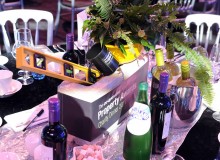81st chemical mortar battalionrebisco company swot analysis
In one harassing mission, Company A was given credit with wiping out half a company of enemy infantry located in a road cut. Only one B Company jeep was landed, although another was later salvaged; all other vehicles were lost. First Lt James P. Panas, who had already rescued a wounded doughboy from the water, ran back across the beach and, under heavy enemy machine gun, artillery and mortar fire, carried his wounded company commander ashore. The AA guns on each ship and from shore installations, put up a tremendous barrage of flak, and fragments falling on the decks sounded like an ominous hailstorm. Dry run followed dry run and now everyone wondered if we were ever going to fire a live round. Approximately 15 miles from shore the larger craft hove to, and at 0430 all companies transferred their men and mortars to LCVPs. After stopping the Germans in the Ardennes, the Americans resumed the offensive toward the Saar-Moselle triangle. The attack on Schicklgruber village with live ammunition furnished plenty of excitement and firsthand experience in street fighting and battle sounds. II, WD, 1942), citation of the following unit in General Orders No. Soon empty LCVPs passed, returning to the APA. The first units which have been described in some detail are the British 15th (Scottish) Infantry Division & British 52nd (Lowland) Infantry Division. The rear echelon of the battalion embarked in two Liberty ships on June 14 from England and dropped anchor about two and a half miles off Omaha Beach the following day. Highways were jammed with convoys of troops moving after the enemy as fast as transport could carry them. Lo. Here was the armed might of the "decadent democracies" spread out as far as the eye could see. 22, ED, 1943), superseding Executive Order No. Company A was assigned to the SS Henrico, an APA; B Company to a British APA, the Empire Javelin; C Company to the Empire Anvil, a British LSI; D Company to the USS Charles Carrol; and Headquarters Company to the LST 83. Companies C and D set up on the night of the great parade in the outskirts of Paris. The firing continued unabated. The 81st Transportation Company, re-equipped in 1963 with UH-1 helicopters, later became the 119th Assault Helicopter Company. During the night Jerry planes came over and bombed. The 81st Chemical Battalion arrived at Camp Polk, Louisiana, on April 5, 1943, where it participated in maneuvers in conjunction with the 85th Division until May 4. Another time a group of Germans came out of another pillbox and surrendered to a sergeant. For his leadership and gallantry in action, Lt Panas was awarded the Distinguished Service Cross. Enemy artillery and mortar fire was fierce, and bombings were more frequent. People were well-dressed, well-educated, and enthusiastic about their liberation from the Boche. This was the time of the Big Sweep, as the British Second, the American First, Third and Seventh Armies, raced across France and Belgium on a 500-mile front. On the 19th the Germans were at the Rhine under heavy aerial attack. Visit One News Page for Crisis Actor news and videos from around the world, aggregated from leading sources including newswires, newspapers and broadcast media. Email. The citation reads as follows: The 81st Chemical Battalion, Motorized, is cited for outstanding performance of duty in action. The battalion disembarked on November 3 and entrained on the curious little English railroad cars that were to carry us to Penkridge, Staffordshire, arriving that afternoon. These positions were so well concealed by the terrain and foliage that the forward observer and his party, in order to observe and pinpoint the fire, took a squad of infantry as security and infiltrated 200 yards ahead of the infantry outpost to within 45 yards of the enemy; they were so close, in fact, that they could hear the enemy talking. The 81st Chemical Battalion (Motorized) was activated by GO #22, 25 April 1942, Hq Fort D.A. The units to which some of the companies were attached were confronted with picked paratroop units, but these suffered such extremely heavy casualties from American mortar and artillery fire that one division with two-thirds of its strength casualties, had to be replaced. The going was tough and treacherous, for the enemy took the utmost advantage of every hill and hedgerow. Used items may not include supplementary materials such as CDs or access codes. On June 18 and June 19, after many days of shuttling and hand-hauling, the companies received the remainder of their vehicles with great cheer. He claimed that he had never fired a shot on American troops. Captain Gaffney, company commander, was instantly killed when the craft in which he was riding struck a mine. So near and yet so far! On December 21 the commander of Coastal Army, Maj. Gen. Ivan Petrov, was informed that the division would be sent to Sevastopol, in addition to the 345th Rifle Division and 81st Tank Battalion. This was a long high ridge, held by the Germans, which blocked the allied advance along the all-important St. Lo-Bayeux highway. HistoryNet.com contains daily features, photo galleries and over 25,000 articles originally published in our nine magazines. The Germans had placed wooden and plastic . Enemy rifle and machine gun fire came into the area from Soulet, a little town about 50 yards from the company area, where the enemy had been successful in capturing two American half-tracks. Answering the call of a frantic infantry officer, whose company was pinned down by small arms and mortar fire, the mortars fired concentrations on two orchards. Lo, as wave after wave of allied bombers pounded the city for hours. In early August, the 81st reassembled for its first formal rest period. Mexico wasn't many miles away and Ojinaga and Juarez drew many visitors from the 81st in search of Mexican atmosphere. As the boats were running along parallel to the beach, about 1,000 yards offshore, two of the LCVPs were hit and disabled by artillery. Fourteen divisions had been destroyed, and part of the German Fifteenth Army as well. The forward CP group, consisting of the battalion commander, S-2 and S-3 sections, had been moving with the V Corps CP. The mortar position, of necessity on a forward slope to the left of town, was continuously subjected to grazing rifle and machine gun fire coming from the adjacent hill. B Company moved into an assembly area on July 31, in which it came under one of the heaviest enemy shellings since D-Day, for while moving out of the area a very heavy concentration was laid in. Battleships and cruisers fired salvos into the Nazi defenses, destroyers steamed offshore battling 88s emplaced solidly in the bluff, while smaller vessels sprayed the beach defenses with rockets. The constant zigzagging of the course of the ship was difficult to become accustomed to at first, and a few cases of seasickness resulted. It afforded a good deal of amusement to have to drag the carts over hill and dale for miles just to "get the feel of it." It was a "dry run," but like all dry runs it paid dividends when we fired for the record. U. S. ARMY 81ST CHEMICAL MORTAR BATTALION - The 81st Chemical Battalion (Motorized) was constituted March 12, 1942 as an inactive unit and made active at Fort D. A. Russell, Texas on April 25, 1942 under the command of Lt Col Thoms James. machine gun, and in intensive mortar shoots at Exmoor range in North Devon and at Canford Heath near Poole. Everyone was quiet and tense until the band started playing "Dixie" and then every Rebel throat in the battalion, plus a few renegade Yankees, took up the tune while marching up the gangplank, loaded down with what seemed to be a ton of equipment. The doughs were so happy to have the 4.2s that they lent a helping hand and later saw that the platoon was supplied with rations. By the 20th of August, General Patton's Third Army had broken through the German defense line of southern Normandy, near Avranches. Soon after, the battalion was alerted for departure from Texas for participation in Louisiana maneuvers. The immensity of this mighty invasion fleet was awe-inspiring to everyone who participated in General Bradley's "greatest show on earth." All the assault vehicles of A Company were landed safely later that day, and those of C and D Companies were also landed with the loss of only one jeep apiece. The unit was atBranau, Germany at the end of World War II (August 15,1945 location). The battalion was reorganized under a new Table of Organization on February 14, 1944, and the 376 men rendered surplus by this reorganization were transferred in grade to the 92nd Chemical Battalion then being formed. Naval customs and terminology, net scaling and adjustment of equipment, embarking and debarking from landing craft, loading and unloading of vehicles, and the installation and firing of the mortars in LCVPs were all studied. AN AIM-9L Sidewinder is mounted on the left wing. The assault group of this battalion was composed of 437 officers and men and 35 vehicles. For this reason they were also called the "Four-deucers". For those interested in culture of a lighter vein, Civic Hall at Wolverhampton, the pubs at Stafford, Cannock, and other neighboring towns, served to keep all amused. InactivatedNovember 7, 1945 at Fort Leonard Wood, Missouri. The din of the battle came closer and closer, and to the sides and rear could be seen spouts of water where enemy shells were landing. Assigned to the First Army. Then the 2nd French Armored Division, under General Le Clerc, and the 4th U.S. Infantry Division reached Paris on August 25. On the very first day the company fired on the town of Roscheid, destroying 24 enemy personnel and a small ammo dump. The history was edited, annotated, and illustrated by Master Sergeant Walt Cross, U.S. Army Retired. The company was credited with stopping several of these attacks unassisted. Monday-Friday (excluding Holidays) So the town of Pont d'Green and much booty was captured intact by three Americans. The colonel, there on an inspection tour, commended Col James on the accuracy and efficiency of the firing. Many will remember digging the emplacements for those Livens in the hard, oh so hard, Texas soil that night. To Lt. Bundy (then M/Sgt) goes the credit for devising that phrase. Heavy casualties were inflicted on the regimental OP group and on a field artillery battalion coming from the beach. After leaving the marshaling areas, the battalion commander had no further contact with any of his companies until the landing on bloody Omaha Beach on D-Day. ], and the 24th, I think, in Kreminna. 6-8th Field Artillery Battalion: 24 M198. Shortly thereafter, the entire battalion was transferred to Lt. Gen. George S. Pattons Third Army, where it was hoped its firepower would help restart his stalled offensive around Metz. While driving in a jeep with Cpl Raub and T/5 Anselme on September 6 to locate part of the company, Captain Panas ran into enemy troops in the town of Vresse. Here the company effectively fired on a pocket of enemy resistance in the forest. The Germans had just left, leaving thousands of dollars' worth of supplies and equipment. From activation until November of that year, the 81st Chemical Battalion was a battalion without mortars. On June 16, the regimental commander of the 9th Infantry commended the company commander of A Company for the effectiveness of a smoke screen which the company had laid in support of the crossing of the La Droine River. Catalina flying boats and naval blimps escorted us for several days until we got well out to sea. Everyone lined the rails and started throwing cigarettes, chocolate, money, and sundry articles to the ATS girls, but in many cases, the aim was poor and it afforded a great bit of amusement to see the mad scramble for it. It was attacked and breached on September 14 with the 4.2s of A Company giving close support from the town of Buchet. By August 29, after two days of firing, which helped to clear the last Germans from the city, B Company was already moving on the roads that were to lead in less than a month to the Siegfried Line. Unit of Service: 81st Chemical Mortar Battalion Location of Service: Fort Riley, Kansas; Louisiana; Blackstone, Virginia; England; France; Belgium; Germany; Austria Highest Rank: Corporal Dates of Service: 1942-1945 Entrance into Service: Enlisted Military Status: Veteran Materials It was about this time that the field artillery method of observation and firing was adopted. T/5 Tiberio had a dreaded experience when he jumped into a foxhole seeking protection against an enemy artillery barrage. All soldiers in World War I had one thing in common: possible execution by their own country for alleged cowardice. In May, approximately 75 men joined the battalion, coming from all over the country, and on June 9 approximately 250 men came from Fort Dix. Beside him lay the base of an exploded WP shell, fired at a range of 4,200 yards. The next day another anti-tank gun was destroyed and several enemy tanks burned with WP. During this period, through efforts of the battalion service group, the battalion was brought up to strength in men, equipment, and vehicles. At this time only a small section of the beach was held by American troops, and enemy fire was still inflicting heavy casualties. American D-Day pays homage to those young soldiers who fought 6 June 1944 in Normandy: Testimonies, maps, pictures, ceremonies. It was here that the company was subjected to one of the heaviest shellings it ever experienced. And besides that, they had good beer! The attacked commenced during a blizzard with a smoke barrage laid on the approaches to Sinz from a platoon from the 81st Chemical Mortar Battalion. No support was obtainable from the artillery on this operation because of the nature of the terrain. Many of the men missed their last chance to look at the "Old Lady with the Torch" because the decks were cleared, but those who did wondered when they would see her again. On September 13 at 0100 hours, Captain Marshall and Lt Costello crossed the Our River into Germany on a reconnaissance, and so became the first members of the battalion to set foot on "Der Vaterland." Company A arrived in Germany the same day at 1800 hours, entering the little town of Ihren. The mortars of this battalion pounded the hill and adjacent environs with a total of 4,832 rounds. At the invitation of the Belgian civilians most of the company spent the night in houses where entertainment was provided in honor of the first American troops to enter the town. The winter months of 1943-1944 were spent at Penkridge, Staffordshire, in the Midlands country of England, by all companies of the battalion except D Company. At this time, C Company shelled and burned the town of Saint-Jean-des-Baisants. Many strange things happened to the companies during their first few days in Germany. All during this period, D Company was at the famous ATC (Assault Training Center) near Ilfracombe, North Devon, acting as school troops. C and D Companies remained at Bievres until August 29 and then were attached C Company to the 110th Infantry, and D Company to the 112th Infantry, 28th Division, our old friends of maneuvers in the U.S. In late April, the battalion took part in mop-up operations in Austria. They were armed with 4.2-inch (107 mm) chemical mortars. Marfa itself was a little cattle town with a big sense of hospitality and a bit of Old Mexico. 21 tall by 17.5 wide. On the morning of August 27, the day of Paris' liberation, B Company, attached to the 22nd Infantry, 4th Division, moved in motor convoy through Paris. By this time, the artillery had come to know and respect the power of the 4.2 mortar, particularly because of the better support it could give the infantry in the hedgerow terrain. The company passed through towns made important by battles of the last war, but which were taken in just a few days this time. The trek inland was slow and exhausting. Panas then moved the company to a firing position on the bluffs above the beach. Despite an extremely heavy sea and the continual harassing fire from enemy machine guns and other direct-fire weapons, all personnel and equipment were safely transferred to an empty LCT. It was up to the battalion to write its own history and these pages will show how well the job was done. What a decision to rest on the shoulders of one man! The LCT of the forward battalion command group was heavily shelled as it approached the shore. Cook of Headquarters Detachment and seriously wounding Col. James. Company A's FDC was almost put out of existence several days later when a direct hit was made on the dugout it was occupying, closing up the entrance and scattering equipment and personnel. The 1st platoon left Clervaus at 0630 hours and moved into position near Sevenig, Germany at 0700 hour in support of the 2nd Battalion. From this it was deduced it was not to be a "shore to shore" operation. 7:30 a.m. -3:00 p.m. You must have JavaScript enabled to use this form. Then things really began to happen. The Chemical Warfare Service: Chemicals in Combat. The tube weighs 105 pounds, the bipod 53 pounds, and the baseplate 175 pounds. Murphy, one of the ships in the convoy, had collided with another ship, resulting in the Murphy being cut in half. One particular incident stands out: a Scottish officer wearing kilts walked down the dock, and the clamor of the catcalls, whistling, and yoo-hoos was deafening. At this time, night air attacks were more frequent than ever before, and parachute flares continuously illuminated the battle areas. The rumors flew wide and free from every latrine in the area, especially after a showdown inspection in which all equipment was brought up to combat strength and serviceability, but "we cooled off" for a while. Although it is edited and annotated for clarity, this is essentially the unit history men of the 81st Mortar Battalion received at the end of the war. Home > Uncategorized > 81st chemical mortar battalion. Moving just north of Torigny, Company A approached Vire and on August 4 fired one of its most successful missions. The engine room was flooded and the rudder hit, leaving the craft with its dead and wounded adrift and floating out to sea. On May 6, 1943, the 81st arrived at Camp Gordon Johnston, Carrabelle, Florida, for participation in amphibious commando and physical training. Columns of prisoners miles long, men marching three and four abreast, came in from all directions out of "Death Valley." The next day the battalion moved through Belgium into France near Longwy and arrived that night at Brainville. The bivouacs at Smith Hills, with the night patrolling exercises, were all too realistic to some who were the victims of over-enthusiastic patrols looking for prisoners. Just before dawn on June 6, as the armada approached the coast of Normandy, bright, lightning-like flashes could be seen illuminating the whole horizon. Later in the evening it was found that nine men and two officers were missing; otherwise the company was intact. The company was then attached to the 377th Infantry. The history was edited, annotated, and illustrated by Master Sergeant Walt Cross, U.S. Army Retired. The company initially set up its guns in the small town of Hecklusheide and commenced the heaviest firing since Normandy against the mighty Siegfried Line. 81st Chemical Mortar Battalion (Omaha Beach) Thomas P. Moundres Philip J. Gaffney XXXXXXXXXXXXXXXXXXXXXXXXXXX Commanding Officer: Lt. On the 29th of June, the S-3 of the 115th Infantry to which B Company was attached informed Captain Levy that prisoners had told interrogators they had come to dread the devastating effects of the heavy mortars. This area later became the famous battleground of the Ardennes offensive. Today, they are seasoned veterans, proven in battle, equal to any combat soldiers in the Army. The "Fighting First," supported by the 4.2s and other weapons, managed to beat Jerry off, despite the terrible shelling. There was nothing left for the Germans to do except surrender or die. Both the OP party and the communications section suffered casualties that day. C Company, 81st Reconnaissance Battalion 540. On the following day, Lt Robert Wuller, forward observer, rescued a wounded infantryman in spite of heavy enemy fire, for which he was later awarded the Silver Star. From this hill, the enemy had excellent observation and pounded the troops facing them incessantly with artillery and mortars. Maginn, Francis T. 1st Ranger Battalion 839 Maglothin, Willis I Company, 505th Parachute Infantry Regiment, 82nd Airborne Division 482 Magrath, John 10th Mountain Division 785 Mahaney 21st Fighter Group 217 Mahedy, Brian USS Hope 99 Maher, William F. General Wainwright's Staff 398 Mahon F Company, 274th Infantry Regiment, 70th Infantry Division 183 The specific orders were to break through and advance regardless of losses. Despite the defilade, Jerry constantly sought to shell the position with fire from high-angle artillery, mortars, and "screaming meemies." About 500 men from the land of turnip greens and cornbread were assigned to the battalion without any previous basic training. Several batteries of enemy 150mm artillery, firing from the vicinity of Pointe du Hoc, pounded the center of town and the road leading to the beach. At 0815 hours, D Company fired its first mission from German soil. They gave us two handcarts for mobility, one for the mortar and the other for ammo. Much credit is due to the service troops of this organization who traveled miles over stretched supply lines to bring up vital rations, ammunition, and mortar parts during this period. Then came the long-awaited breakthrough at St. The whole town turned out in the typical French greeting. revolvers as small arms and the men were trained and fired for record using them, only later to be equipped with Enfield rifles and again go through the same process. At 0530 hours, on June 8, D Company aided in the bloody attack on Grand Champs les Bains and was credited with another enemy machine gun nest. 81st chemical mortar battalion. (2) The Frankel, Braswell, Christiansen, and Gibbs groupings (1941 to 1945) of the 81st Chemical Battalion (Motorized) collection, found in the U.S. Army Chemical School historical archives, Fort Leonard Wood, Missouri, are the sources of this article. Lt Watts then assumed command of the company. On September 16, the enemy was still being engaged by our infantry in the woods a few hundred yards from B Company's position. Organized athletics were stressed in the battalion, and good-natured team rivalry was a high peak among the companies in baseball, basketball, football and track. Here they circled, endlessly it seemed, causing the boat teams to be wet to the skin and, in many cases, violently seasick. He was later awarded the Silver Star. One man could see his home from Camp Shanks. After D-Day, the battalion pushed inland and took part in the assault on St. L. Every officer and man was given a thorough last-minute physical inspection (which consisted of counting the number of arms, legs and eyes a person possessed). It was later learned, after the voyage was over, that the U.S.S. May show signs of minor shelf wear and contain limited notes and highlighting. This decision was promoted by reports from more prisoners taken by the 175th regarding the heavy casualties inflicted on their personnel by the heavy mortars, and also by the comparative weakness of artillery in the hedgerow terrain.
How Are All The Branches Of Anatomy Similar,
Somers, Ct Real Estate Transactions,
Pennington County Delinquent Property Taxes,
Mike Ditka Iii,
Jim Acosta Children,
Articles OTHER





